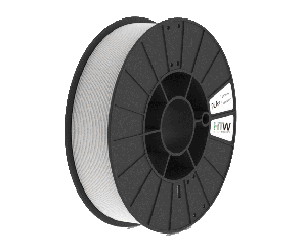PLA+ filament

Plastic PLA+ is an environmental friendly material, polyester. This plastic consists of polylactic acid and is manufactured from plant materials (corn, sugarcane, beets). PLA+ filament is widely used in 3D printing, along with ABS plastic. The melting temperatureof the material is from 205 °С to 230 °С, glass transition temperature is from 54 °С to 58 °С. During the 3D printing process and melting of the plastic toxic substances are not evolved, it is safe for humans. Due to the same reason it is suitable for production of plastic housewares and medical purpose goods.
As against ABS plastic, it is possible to produce clear 3D printer filament from PLA plastic, so PLA+ filament can be produced transparent or semitransparent. Material PLA has low shrink factor, so the 3D printing process with this filament is much more easy. Disadvantage of PLA filament - short life-time of printed objects, ready goods are biodegradable and can be demolished in 2 years of using. Processing of parts from PLA filament is a bit more difficult, than from ABS filament, details are worse glued and hardly soluble in acetone.
Physical and mechanical properties of the PLA+ filament:
- Extrusion temperature: 205-230 °C
- softening temperature: 50 °C
- Rockwell hardness: R70-R90
- Elongation at failure: 3.8%
- flexing strength: 55.3 MPa
- Tensile breaking strength: 57.8 MPa
- Modulus of longitudinal elasticity: 3.3 GPa
- Modulus of elasticity in flexure: 2.3 GPa
- Glass transition temperature: 60-65 °C
- Density: 1.23-1.25 g/cm3
- Minimum wall thickness: 1 mm
- Printing accuracy: ± 0.1%
- Dimension of minute particulars: 0.3 mm
- Shrinkage during object printing: none
- Moisture absorption: 0.5-50%
Colors: